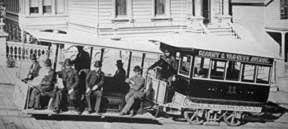TRANSPORTATION
As late as the 1880s, many of the major cities in the United States still had unpaved streets that were an instant hazard to all vehicles whenever the rains came. The primary materials for creating streets were either wood, which wore quickly, paving bricks, or the ubiquitous cobblestones. Sidewalks, where they existed, were made of wood or some form of brick. By 1900, concrete and cement were in use for sidewalks, and some gravel-based aggregates similar to asphalt were laid on the streets, cutting down on dust and mud. The automobiles of the ragtime era had large wheels similar to those of their wagon ancestors, except with narrow rubber tires. With such good ground clearance, they were able to negotiate mud with some small level of efficiency. But when the increasing size of cars and tire widths started to wear down those roads, asphalt and concrete were necessary to make city streets more durable. Viaducts and bridges also required redesign to accommodate the new heavier surfaces, starting with steel reinforcement of the bridge material itself. This created problems during the time of transition to the automobile, as the harder surfaces were uncomfortable for horses to walk or gain traction on. They also reacted adversely to the congestion and noise of the inner city, making them a less palatable form of transportation. So it is just as likely that the reason civilian horses all but disappeared from the cities by the 1920s was due to the roads as much as it was the advent of self-powered vehicles.
A San Francisco cable car circa 1890s |
The commuting patterns in the city changed less drastically during the ragtime era than they did in rural areas. It was common to live within a short distance of work, often a few blocks walk or a matter of a couple of miles. While the
subway slowly gained acceptance as a viable means of commuting in Boston and New York, other cities were more reliant on surface or elevated transportation. Chicago and New York both had elevated railways that initially employed steam locomotives, mostly converted to electric by the mid 1910s. Most urban areas had some form of streetcar or cable car, which was ideal for a quick trip to work or the markets. The
cable car took hold quickly in San Francisco because of its reliable torque and minimal track slippage, making hill climbing nearly effortless. Los Angeles had its famous
Red Car trolley line that lasted into the early 1960s, and an early foray into a subway that resulted in a two-mile long tunnel that was abandoned within two decades of construction. Washington D.C. had a similar streetcar system. But the layout of burgeoning Manhattan Island made grade-level rail transportation on that island difficult at best. The building congestion in the streets during the 1910s along with the propensity of white-collar workers to move further from the center of Manhattan helped establish the commuting infrastructure and patterns that still exist today. While many there own cars, they rarely use them for commuting, much as was the case by the end of the First World War. So while most other urban areas started fortifying their road systems, planners in Manhattan were expanding the subway lines instead. Much of this would change in the 1940s and 1950s, but some of that balance has returned to NYC at the start of a new century.








 Loading Page. Please Wait...
Loading Page. Please Wait... 




